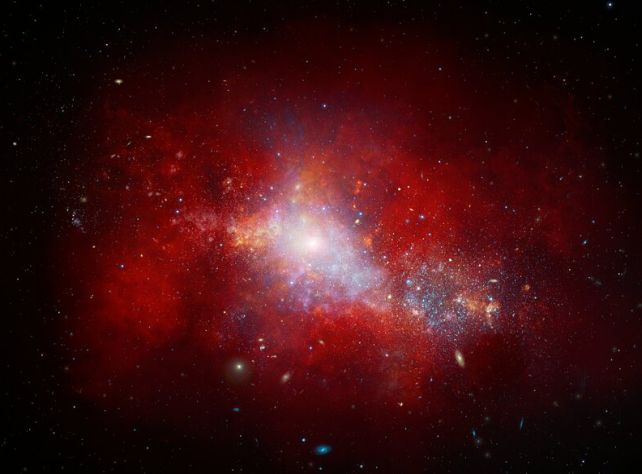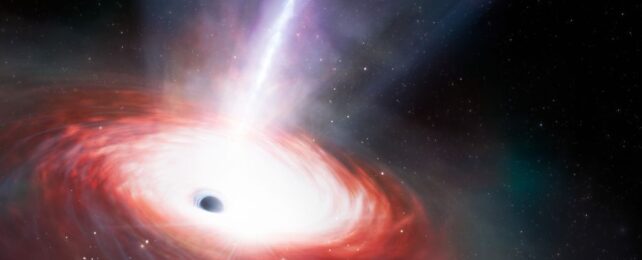A supermassive black hole in the early Universe is the most voracious of its kind we've ever seen.
It's sitting in the middle of a galaxy called LID-568, as seen just 1.5 billion years after the Big Bang, appearing to guzzle down material at a jaw-dropping rate of over 40 times a theoretical maximum known as the Eddington limit.
We've never seen anything like it – and it's a discovery that could help us unravel one of the greatest mysteries of the early Universe: how supermassive black holes get so incredibly massive in such a short period of time following the Big Bang.
"This black hole is having a feast," says astronomer Julia Scharwächter of Gemini Observatory and NSF's NOIRLab. "This extreme case shows that a fast-feeding mechanism above the Eddington limit is one of the possible explanations for why we see these very heavy black holes so early in the Universe."
The Eddington limit is a natural consequence of the black hole feeding process. When a black hole actively accretes large amounts of material, that material doesn't fall straight into the gravity well, but first swirls like water circling a drain, with only the material at the inner edge of the disk crossing the horizon into the black hole.

The incredible amount of friction and gravity heats this disk of material to extremely hot temperatures, causing it to blaze with light. But the thing about light is that it exerts a form of pressure.
A single photon isn't going to do much, but the blaze of an active supermassive black hole accretion disk is another matter. At a certain point, the outward pressure of radiation matches the inward gravitational pull of the black hole, preventing material from moving closer. That's the Eddington limit.
Breaking the Eddington limit of accretion is possible. It's known as super-Eddington accretion, during which the black hole goes absolutely ham, slurping up as much mass as it can before radiation pressure takes over. This is one way astronomers believe supermassive black holes at the dawn of time could attain masses that defy easy explanation.
Led by astronomer Hyewon Suh of Gemini Observatory and NSF's NOIRLab, a team of researchers used JWST to take follow-up observations of a smattering of galaxies identified by the Chandra X-ray Observatory that were bright in X-rays but dim in other wavelengths.
When they got to LID-568, they were having trouble identifying its distance across space-time. The galaxy was very faint and very hard to see; but, using the integral field spectrograph on JWST's NIRSpec instrument, the team homed in on the galaxy's exact position.

LID-568's far-off location is surprising. Although the object is faint from our position in the Universe, its distance means it must be incredibly intrinsically bright. Detailed observations revealed powerful outflows from the supermassive black hole, a signature of accretion as some of the material is being diverted and blasted into space.
A painstaking analysis of the data revealed that the supermassive black hole is a relatively small one, as supermassive black holes go; just 7.2 million times the mass of the Sun. And the amount of light being produced by the material around the disk was much, much higher than a black hole of this mass should be capable of producing. It suggests an accretion rate some 40 times higher than the Eddington limit.
At this rate, the period of super-Eddington accretion should be extremely brief, which means Suh and her team were extremely lucky to catch it in action. And we expect that LID-568 will become a popular observation target for black hole scientists, allowing us a rare glimpse into super-Eddington processes.

In turn, this could help us understand the early Universe. There is evidence to suggest that the first supermassive black holes formed not from collapsing stars as we know them, but from huge stars and huge clumps of gas, directly collapsing under gravity. This would give them a headstart on their way to becoming the giant black holes we see in the Universe today. Bursts of super-Eddington accretion could be another piece of the puzzle.
"The discovery of a super-Eddington accreting black hole suggests that a significant portion of mass growth can occur during a single episode of rapid feeding," Suh says, "regardless of whether the black hole originated from a light or heavy seed."
The research has been published in Nature Astronomy.
